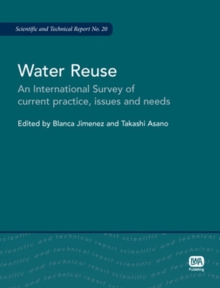
Land Use and Water Quality: The impacts of diffuse pollution PDF
by Puangrat Kajitvichyanukul, Brian D' Arcy
Part of the Scientific and Technical Report Series series
Description
The influence of landscapes – topography, soil, vegetation, geology - on water quality is an inherent part of the global water cycle.
Land use has adverse impacts for example when soils are exposed, significant quantities of pollutants are released (including anthropogenic materials added to those naturally present), or pollutants are added directly to the water environment. Those impacts range from industrial development to farming and urbanisation.
Whilst inefficient polluting industrial effluents are still tolerated in some countries, and poorly treated sewage globally remains a huge challenge for sanitation and public health, as well as the water environment, diffuse pollution is relatively poorly recognised or understood.
The operator of a sewage or trade effluent treatment plant is consciously discharging effluent to the local river.
But a farmer is simply growing crops or farming livestock, a city commuter driving to work is unlikely to be thinking how brake pad wear has released copper to the water (and air) environment and hydrocarbons and particulates too; no one is intending to cause pollution of the water environment.
The same applies to industrial chemists creating fire-proofing chemicals, solvents, fertilisers, pesticides, cosmetics and many more substances which contaminate the environment.
Understanding and ultimately minimising diffuse pollution is in that sense the science of unintended consequences. And the consequences can be severe, for water resources and ecosystems.
It’s a global problem. This book comprises 18 papers from experts around the globe, presenting evidence from tropical as well as temperate regions, and rural as well as urban land use challenges.
The book explores the nature of diffuse pollution and exemplifies the issues at various scales, from high-level national overviews to particular catchment and pollutant issues. By contrast, natural or semi-natural forest cover has long been recognised as safeguarding water quality in reservoirs (examples from Australia to Thailand and UK).
The final chapter looks at how landscapes generally, can be designed to minimise pollution risks from particular land-uses, arguing for a more widespread catchment approach to water-aware landscape design, allied with flood risk resilience, place-making for people, and biodiversity opportunities too.
Information
-
Download - Immediately Available
- Format:PDF
- Pages:280 pages
- Publisher:IWA Publishing
- Publication Date:15/05/2022
- Category:
- ISBN:9781789061123
Information
-
Download - Immediately Available
- Format:PDF
- Pages:280 pages
- Publisher:IWA Publishing
- Publication Date:15/05/2022
- Category:
- ISBN:9781789061123










